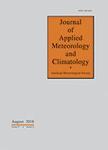版权所有:内蒙古大学图书馆 技术提供:维普资讯• 智图
内蒙古自治区呼和浩特市赛罕区大学西街235号 邮编: 010021

作者机构:NOAA Field Res Div Air Resources Lab 1750 Foote Dr Idaho Falls ID 83402 USA Washington State Univ Lab Atmospher Res Pullman WA 99164 USA Univ Tennessee Inst Space Tullahoma TN 37388 USA
出 版 物:《JOURNAL OF APPLIED METEOROLOGY AND CLIMATOLOGY》 (应用气象学与气候学杂志)
年 卷 期:2016年第55卷第6期
页 面:1305-1322页
核心收录:
学科分类:07[理学] 070601[理学-气象学] 0706[理学-大气科学]
基 金:NOAA National Science Foundation Division of Atmospheric and Geospace Sciences Div Atmospheric & Geospace Sciences Directorate For Geosciences Funding Source: National Science Foundation
主 题:Atm/Ocean Structure/ Phenomena Mixing Stability Physical Meteorology and Climatology Diffusion Dispersion Observational techniques and algorithms Tracers
摘 要:The first phase of an atmospheric tracer experiment program, designated Project Sagebrush, was conducted at the Idaho National Laboratory in October 2013. The purpose was to reevaluate the results of classical field experiments in short-range plume dispersion (e.g., Project Prairie Grass) using the newer technologies that are available for measuring both turbulence levels and tracer concentrations. All releases were conducted during the daytime with atmospheric conditions ranging from neutral to unstable. The key finding was that the values of the horizontal plume spread parameter sigma(y) tended to be larger, by up to a factor of similar to 2, than those measured in many previous field studies. The discrepancies tended to increase with downwind distance. The values of the ratio sigma(y)/sigma(theta), where sigma(theta) is the standard deviation of the horizontal wind direction, also trend near the upper limit or above the range of values determined in earlier studies. There was also evidence to suggest that the value of sigma(y) began to be independent of sigma(theta) for sigma(theta) greater than 18 degrees. It was also found that the commonly accepted range of values for sigma(theta) in different stability conditions might be limiting, at best, and might possibly be unrealistically low, especially at night in low wind speeds. The results raise questions about the commonly accepted magnitudes of sigma(y) derived from older studies. These values are used in the parameterization and validation of both older stability-class dispersion models as well as newer models that are based on Taylor s equation and modern PBL theory.